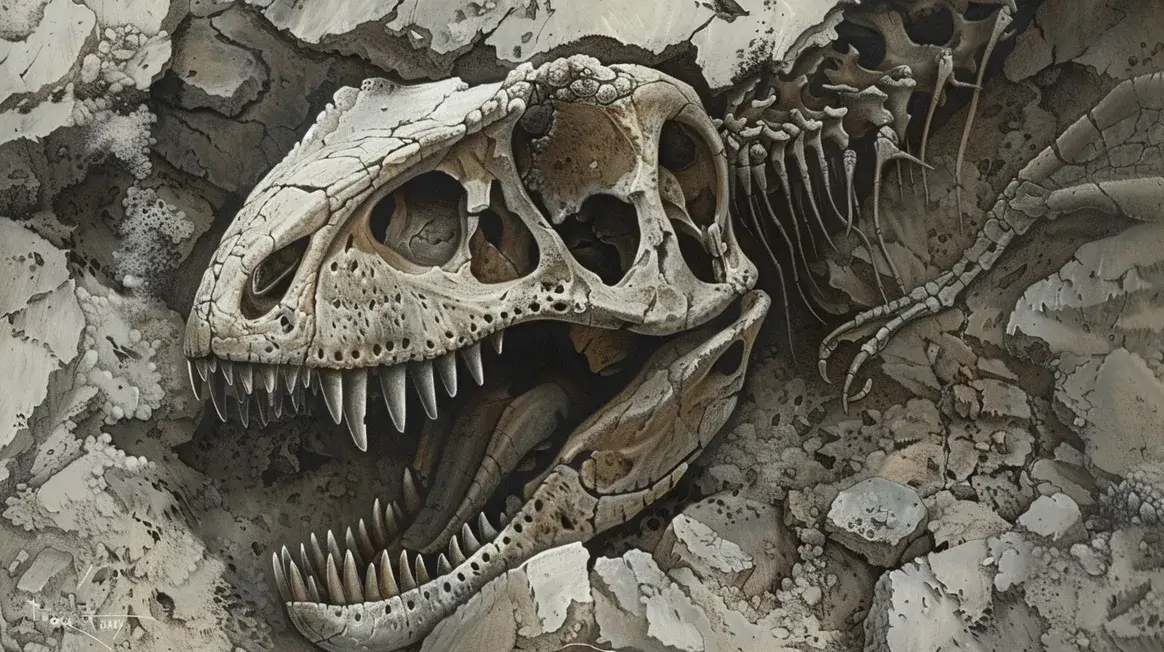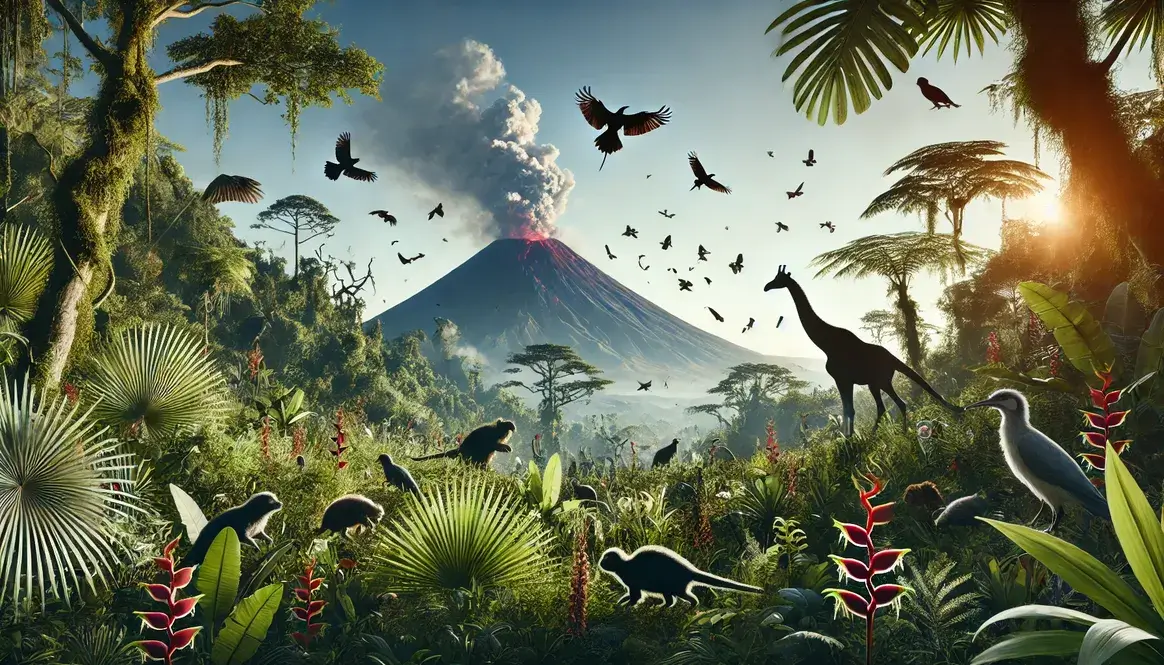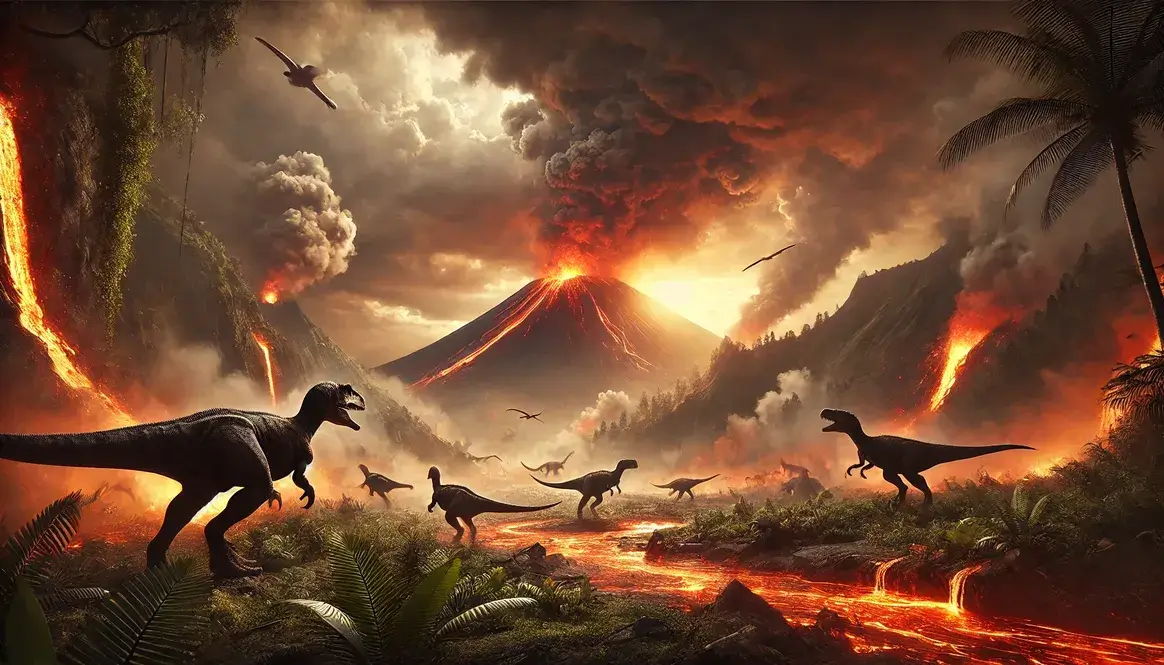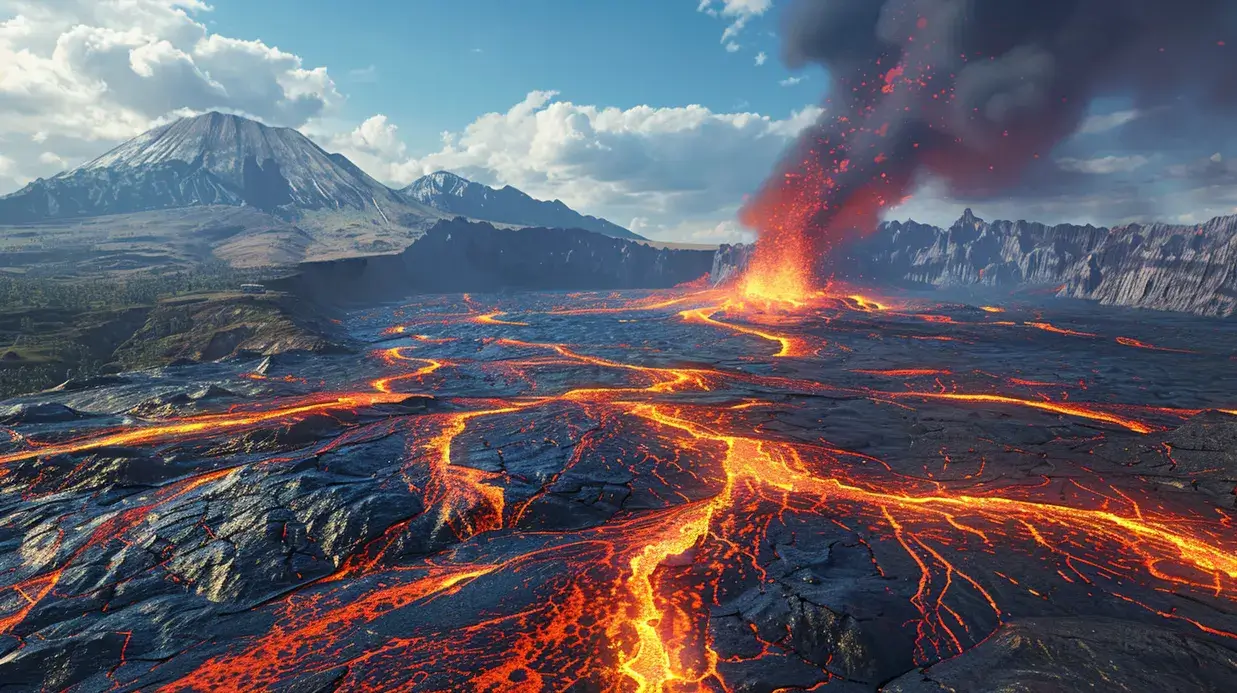The Cretaceous-Paleogene (K-Pg) boundary represents one of the most dramatic turning points in Earth’s history. Occurring approximately 66 million years ago, this boundary marks a mass extinction event that led to the disappearance of about 75% of Earth’s species, including all non-avian dinosaurs. While the asteroid impact theory has long been the dominant explanation, recent research suggests that mercury pollution from massive volcanic eruptions may have played a crucial role in this global catastrophe.
This article explores the hypothesis that volcanic activity, specifically mercury emissions from the Deccan Traps in India, contributed significantly to the environmental changes that triggered the K-Pg mass extinction. We will delve into the significance of the K-Pg boundary, discuss the leading theories behind the extinction event, and examine the geological evidence supporting the role of mercury pollution from K-Pg volcanoes.
| Key Facts | Mercury Pollution from K-Pg Volcanoes |
|---|---|
| Main Source | Deccan Traps volcanic eruptions |
| Time Period | End of Cretaceous (66 million years ago) |
| Mercury Release | Massive amounts into atmosphere and oceans |
| Impact | Contributed to mass extinction of dinosaurs |
| Evidence | High mercury levels in K-Pg boundary rock layers |
The volcanic source of mercury
K-Pg volcanoes were massive volcanic eruptions that happened during the Cretaceous-Paleogene (K-Pg) boundary. They spewed out huge amounts of lava, gases, and – you guessed it – mercury. This mercury pollution from K-Pg volcanoes played a big role in changing Earth’s environment and making life tough for many animals, including dinosaurs.
Deccan Traps: A major mercury contributor
The Deccan Traps in India were the biggest source of mercury pollution from K-Pg volcanoes. Imagine a volcanic area as big as France – that’s how large the Deccan Traps were! These volcanoes erupted for hundreds of thousands of years, releasing enormous amounts of mercury into the air and water.
Scientists have found that the Deccan Traps released about 99,000 metric tons of mercury during their active period. That’s like filling up 40 Olympic-sized swimming pools with liquid mercury! This huge amount of mercury spread all over the world, causing problems for plants and animals everywhere.
Other K-Pg volcanic activity
While the Deccan Traps were the main culprit, they weren’t the only source of mercury pollution from K-Pg volcanoes. Other volcanic eruptions happened around the world during this time, adding to the mercury problem. Some of these volcanoes were underwater, releasing mercury directly into the oceans.
For example, there were volcanic eruptions in:
- North America
- The Caribbean
- The North Atlantic
These other volcanoes might not have been as big as the Deccan Traps, but they still contributed to the overall mercury pollution. Together with the Deccan Traps, they created a perfect storm of environmental changes that made life hard for many species, including dinosaurs.
Mercury pollution from K-Pg volcanoes: The process
The process of mercury pollution from K-Pg volcanoes is a fascinating chain of events that starts deep within the Earth and ends up affecting life all over the planet. Let’s break it down step by step.
Volcanic eruptions and mercury release
When volcanoes erupt, they don’t just spew out lava and ash. They also release gases and tiny particles, including mercury. Here’s how it happens:
- Mercury source: Deep underground, mercury is trapped in rocks and magma.
- Heat and pressure: As the magma rises, high temperatures and pressure cause the mercury to vaporize.
- Eruption: When the volcano erupts, the mercury vapor is released along with other gases.
- Particle attachment: Some mercury attaches to volcanic ash particles.
The amount of mercury released depends on the size and type of eruption. The Deccan Traps eruptions were especially massive, releasing huge amounts of mercury over a long period.
Atmospheric transport of mercury
Once the mercury is released into the air, it doesn’t just stay put. It travels far and wide, spreading its effects across the globe. This is why mercury pollution from K-Pg volcanoes was such a big deal.
Mercury in the atmosphere can take three main forms:
| Form of Mercury | Description | Transport Distance |
|---|---|---|
| Elemental mercury | Vapor form, can stay in air for up to a year | Global |
| Reactive gaseous mercury | Easily deposited on surfaces | Regional |
| Particulate mercury | Attached to ash particles | Local to global |
The elemental mercury vapor can travel around the world before it falls back to Earth. This means that even areas far from the volcanoes were affected by the mercury pollution.
Wind patterns play a big role in how mercury spreads. During the K-Pg period, the Earth’s climate was different from today, which affected how the mercury was distributed. Some areas got more mercury than others, depending on wind directions and rainfall patterns.
When the mercury finally falls back to Earth, it can end up in soil, water, and even in the bodies of plants and animals. This is where the real trouble begins, as mercury starts to build up in the food chain.
Learn more about how volcanoes impact the climate and how this might have affected dinosaurs and other ancient life forms.
Evidence in the geological record
Scientists are like detectives when it comes to studying mercury pollution from K-Pg volcanoes. They search for clues left behind in rocks and sediments from millions of years ago. This evidence helps them piece together the story of what happened during this crucial time in Earth’s history.
Mercury concentrations in K-Pg boundary layers
One of the most important pieces of evidence comes from the K-Pg boundary layer. This is a thin layer of rock that marks the end of the Cretaceous period and the beginning of the Paleogene period. Scientists have found something very interesting in this layer: unusually high levels of mercury.
Here’s what they’ve discovered:
- Mercury spikes: In many K-Pg boundary layers around the world, there’s a sudden increase in mercury concentrations.
- Comparison to normal levels: These mercury levels are much higher than what’s typically found in rocks from other time periods.
- Timing: The mercury spikes line up perfectly with the time of intense volcanic activity and the extinction of the dinosaurs.
This elevated mercury in the rocks is like a fingerprint left behind by the massive volcanic eruptions of the time. It’s strong evidence that mercury pollution from K-Pg volcanoes was a real and significant event.
Global distribution of mercury signals
What makes the evidence for mercury pollution from K-Pg volcanoes even more convincing is that it’s found all over the world. Scientists have discovered high mercury levels in K-Pg boundary layers on every continent!
Here are some examples of where mercury signals have been found:
- North America: High mercury levels in rocks from Montana and New Jersey
- Europe: Elevated mercury in K-Pg boundary clays in Denmark and Spain
- Asia: Mercury spikes in sediments from India and China
- South America: Increased mercury in K-Pg layers in Brazil
- Africa: Higher than normal mercury levels in Tunisia
This global distribution shows just how far-reaching the effects of the volcanic eruptions were. The mercury released by volcanoes like the Deccan Traps didn’t just stay in one place – it spread all around the planet.
Scientists use special tools and techniques to measure these tiny amounts of mercury in ancient rocks. They might use:
- Mass spectrometers to measure mercury concentrations
- X-ray fluorescence to detect mercury in rock samples
- Chemical analysis of sediment cores from the deep ocean
By studying these global mercury signals, researchers can better understand how mercury pollution from K-Pg volcanoes affected different parts of the world. This helps them piece together a more complete picture of what the Earth was like during this tumultuous time, and how it might have contributed to the extinction of the dinosaurs.
Effects on Cretaceous ecosystems
The mercury pollution from K-Pg volcanoes didn’t just change the environment – it had serious effects on the plants and animals living at the time. Let’s explore how this pollution impacted life during the late Cretaceous period.
Mercury accumulation in food chains
When mercury enters an ecosystem, it doesn’t stay in one place. Instead, it moves through the food chain, becoming more concentrated at each level. This process is called biomagnification. Here’s how it works:
- Plants absorb mercury: Mercury in soil and water is taken up by plants.
- Herbivores eat plants: Plant-eating animals ingest the mercury.
- Carnivores eat herbivores: Meat-eating animals consume even more mercury.
- Top predators: The highest levels of mercury build up in top predators.
This table shows how mercury might have built up in a Cretaceous food chain:
| Organism | Mercury Level | Relative Concentration |
|---|---|---|
| Algae | Low | 1x |
| Small fish | Medium | 10x |
| Large fish | High | 100x |
| Marine reptile | Very high | 1000x |
As you can see, animals at the top of the food chain, like large marine reptiles or terrestrial predators, would have been exposed to much higher levels of mercury than smaller organisms.
Toxic effects on Cretaceous animals and plants
Mercury is a powerful neurotoxin, which means it can damage the nervous system. For Cretaceous life forms, exposure to high levels of mercury from volcanic pollution could have caused a range of problems:
- Plants: Mercury can interfere with photosynthesis and seed germination, potentially leading to reduced plant growth and forest die-offs.
- Insects: Mercury exposure could have affected insect behavior and reproduction, disrupting important ecological roles like pollination.
- Fish and marine life: Aquatic ecosystems were likely hit hard, with mercury causing:
- Reduced reproduction rates
- Impaired growth and development
- Neurological damage affecting behavior
- Dinosaurs and other large animals: Top predators and large herbivores might have experienced:
- Difficulty hunting or foraging due to neurological effects
- Reduced fertility and birth defects
- Weakened immune systems, making them more susceptible to diseases
It’s important to note that different species would have been affected in different ways. Some might have been more sensitive to mercury, while others might have had ways to cope with the pollution.
The effects on ancient life from mercury pollution, combined with other environmental stresses like climate change and the asteroid impact, created a perfect storm of conditions that many species couldn’t survive. This helps explain why the K-Pg extinction was so severe, affecting a wide range of plants and animals across the globe.
Understanding how mercury pollution from K-Pg volcanoes affected Cretaceous ecosystems gives us important insights into this critical period in Earth’s history, and helps us better understand the complex factors that led to the extinction of the dinosaurs.
Mercury’s role in the K-Pg extinction
The mercury pollution from K-Pg volcanoes played a significant part in one of Earth’s most dramatic events: the extinction of the dinosaurs and many other species. While it wasn’t the only factor, mercury contamination added to the environmental stress that pushed many species to the brink.
Weakening of ecosystems
Mercury pollution didn’t just affect individual animals or plants; it weakened entire ecosystems. Here’s how:
- Food web disruption: As mercury built up in food chains, it affected species at all levels. This disrupted the delicate balance of predator-prey relationships.
- Reduced biodiversity: Some species were more sensitive to mercury than others. As these species declined, it reduced the overall diversity of ecosystems, making them less resilient to changes.
- Habitat degradation: Mercury pollution could have damaged important habitats, like forests or coral reefs, that many species depended on for survival.
- Reproductive issues: Mercury’s effects on reproduction meant that many species struggled to maintain their population numbers.
Think of ecosystems like a giant game of Jenga. Mercury pollution was like removing blocks from the tower, making it more unstable and likely to collapse when faced with additional pressures.
Interaction with other extinction factors
Mercury pollution from K-Pg volcanoes didn’t act alone. It combined with other environmental stressors to create a “perfect storm” for extinction. Let’s look at how mercury interacted with some of these other factors:
Climate change: The Deccan Traps eruptions released huge amounts of carbon dioxide, leading to global warming. Mercury pollution made it harder for species to adapt to these changing conditions.
Mercury effect + Climate change = Increased difficulty in adaptation
Ocean acidification: Volcanic activity also led to more acidic oceans. Mercury pollution added another layer of stress for marine life already struggling with changing ocean chemistry.
Asteroid impact: While the asteroid impact was a sudden, catastrophic event, mercury pollution had been weakening species and ecosystems for thousands of years beforehand. This made it harder for many species to survive the aftermath of the impact.
| Extinction Factor | Effect on Its Own | Combined with Mercury |
|---|---|---|
| Climate change | Habitat shifts | Faster decline of sensitive species |
| Ocean acidification | Shell formation issues | More severe impacts on marine food webs |
| Asteroid impact | Sudden environmental changes | Reduced resilience to recover from impact |
By understanding how mercury pollution interacted with these other factors, scientists can better explain why the K-Pg extinction was so severe and widespread. It’s a reminder that extinction events are often the result of multiple, interacting causes rather than a single factor.
This complex interplay of factors, including mercury pollution from K-Pg volcanoes, created an environment where many species, including the dinosaurs, simply couldn’t survive. It’s a sobering lesson in how changes in Earth’s systems can have far-reaching and long-lasting effects on life.
Lessons from ancient mercury pollution
The story of mercury pollution from K-Pg volcanoes isn’t just about the past. It holds valuable lessons for our present and future. By studying this ancient event, scientists can better understand and prepare for modern environmental challenges.
Implications for modern volcanic activity
Our knowledge of mercury pollution from K-Pg volcanoes has changed how we monitor and understand current volcanic activity. Here’s how:
- Improved monitoring: Scientists now include mercury measurements in their volcanic monitoring programs. This helps them better assess the potential environmental impact of eruptions.
- Early warning systems: Unusual mercury levels in soil or water near volcanoes could serve as an early warning sign of increased volcanic activity.
- Long-term impact assessment: Understanding how the Deccan Traps affected global ecosystems helps volcanologists predict the potential long-term effects of large-scale modern eruptions.
- Risk assessment: By studying how mercury from K-Pg volcanoes spread globally, scientists can better predict how pollutants from modern volcanoes might disperse.
These insights allow us to be better prepared for volcanic events and their potential environmental consequences. For example, if a large eruption were to occur today, we would be more aware of the need to monitor not just immediate dangers like lava flows, but also long-term effects like mercury pollution.
Relevance to current environmental concerns
The ancient mercury pollution event also sheds light on current environmental issues:
Global pollution spread: Just as mercury from K-Pg volcanoes spread worldwide, modern pollutants can have global impacts. This underscores the need for international cooperation in addressing environmental problems.
Biomagnification: The way mercury built up in ancient food chains is similar to how pollutants accumulate in modern ecosystems. This helps us understand the long-term risks of pollutants that persist in the environment.
Ecosystem resilience: Studying how some species survived the K-Pg extinction despite mercury pollution can provide insights into building more resilient ecosystems today.
Climate change interactions: The interaction between mercury pollution and climate change during the K-Pg extinction parallels current concerns about how different environmental stressors might combine to create larger problems.
Moreover, this ancient event reminds us of the interconnectedness of Earth’s systems. Just as volcanoes affect evolution over long periods, human activities today can have far-reaching and long-lasting impacts on our planet’s ecosystems.
By learning from the past, we can make more informed decisions about how to protect our environment and the diverse life it supports. The story of mercury pollution from K-Pg volcanoes serves as a powerful reminder of our planet’s vulnerability to change and the importance of understanding and preserving the delicate balance of Earth’s ecosystems.









